Åland Islands Travel Guide
Welcome to the taste2travel Åland Islands Travel Guide!
Date Visited: May 2018
Introduction
Until recently, I had no idea of the existence of the Åland Islands – an autonomous, demilitarised, Swedish-speaking territory of Finland. After visiting them, I have become a fan but whenever I mention them, people have no idea where in the world I’m talking about.
Unlike other European territories, such as Denmark’s Faroe Islands or the UK’s Jersey, Guernsey or Isle of Man, the Åland Islands remain well off the radar.

Souvenir Åland Islands flags on sale in Mariehamn.
The only people who seem to be aware of Åland’s existence are its neighbours – the Swedes and Finns, who arrive in droves every summer to relax and chill-out on one of the many peaceful islands which can be found throughout the archipelago.

Åland islands Welcome sign.
The territory has its own government, produces its own stamps, issues its own passports (although, unlike other territories, the passport of the Åland Islands does not indicate a different nationality, with all holders being Finnish nationals), has its own internet top-level domain (.AX) and its own vehicle license plate.

The Åland Islands number plate on my rental car.
While Åland is an archipelago of more than 26,000 islands (yes, you’ve read that correctly), only 65 islands are inhabited. The mainland is known locally as Fasta Åland (“Main Island”) and its here you’ll find 90% of the population living on 70% of the total land area and its the focus of this travel guide.
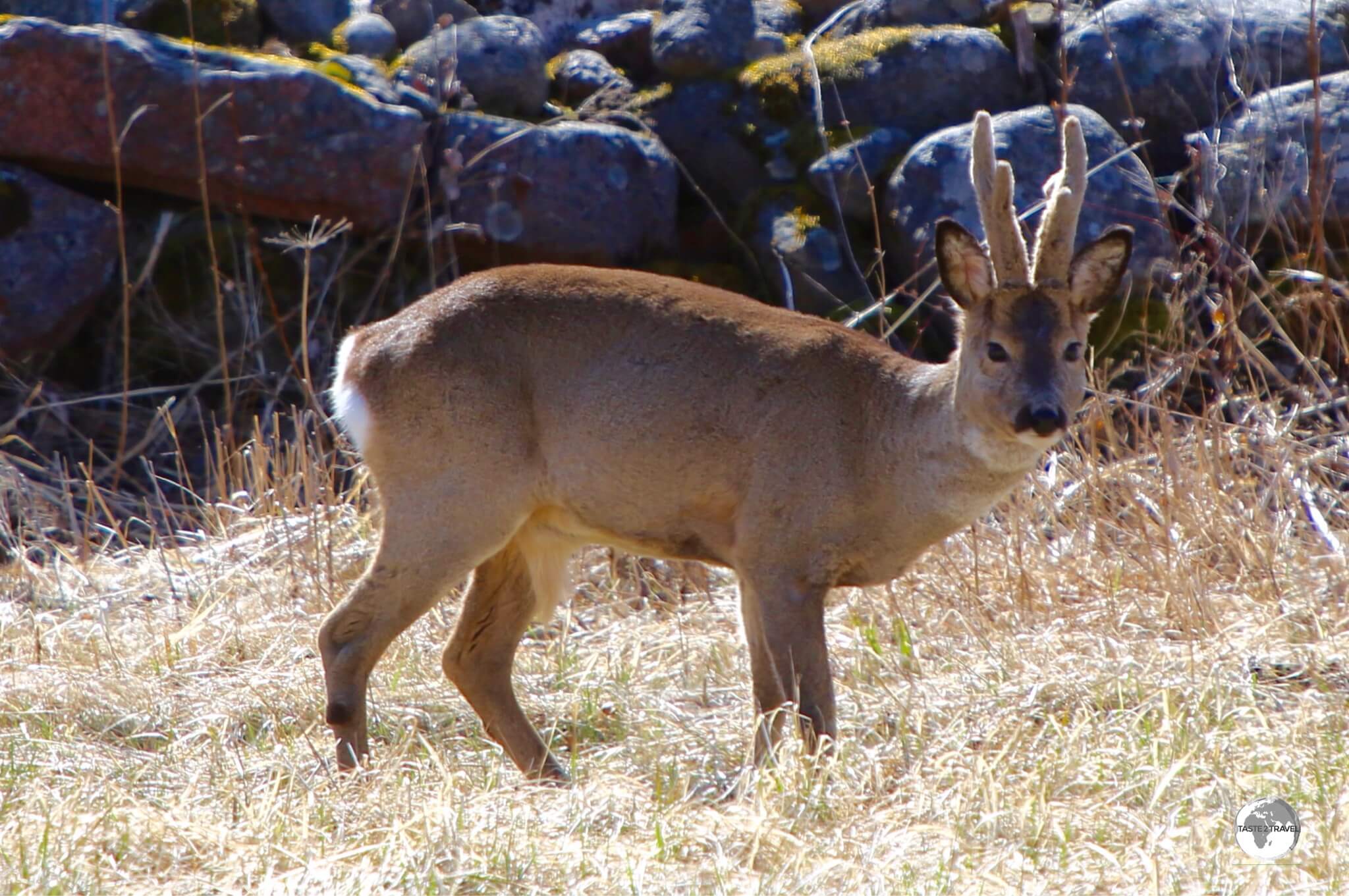
There are an estimated 15,000 Roe deer on the Åland Islands.
If you’re looking to visit a place well off the standard tourist trail, a destination offering a unique culture, centuries of history, wildlife and beautiful nature then the Åland Islands are a place to add to your bucket list.
Location
Åland Islands
Located like a stepping stone between Sweden and Finland, the Åland Islands are an archipelago in the Baltic Sea. Fasta Åland is separated from the coast of Sweden by 38 kilometres (24 miles) of open water to the west. In the east, the Åland archipelago is contiguous with the Finnish Archipelago Sea.

Typical Åland landscape.
This autonomous territory lies at the entrance to the strategically important Gulf of Bothnia, the northern arm of the Baltic sea which separates Sweden from Finland.

The flag of the Åland Islands (centre) surrounded by the flags of its all important, powerful neighbours – Sweden and Finland.
History

Displays at the Åland Museum detail the history of the islands.
The first settlers arrived on the Åland Islands more than 6000 years ago, after the islands had begun to re-emerge from the sea following the end of the last ice age. Both Stone Age and Bronze Age people inhabited the archipelago, obtaining food by hunting seals and birds, fishing, and gathering plants.

During the Middle ages, Kastelholm Castle played a key role in the expansion of the Swedish Empire.
Due to its strategic location between Sweden and Finland, Åland was an important harbour and trading centre during the Viking age, and evidence has been found of six fortresses from that time. The islands were Christianised during the 12th century by Swedish missionaries and later became a part of the Swedish Empire, which exercised territorial control over much of the Baltic region during the 17th and early 18th centuries.

The walls of Bomarsund fortress were constructed using giant hexagonal-shaped granite blocks.
In September of 1809, following Russia’s victory over Sweden in the Finnish war, Sweden signed the Treaty of Fredrikshamn surrendering control of the Åland Islands, along with Finland.
The Russians then incorporated Åland into the larger, semi-autonomous Grand Duchy of Finland (the predecessor to modern Finland).
During the treaty negotiations, the Swedes failed to secure a provision from the Russians that the islands would never be fortified, which was important to the Swedes as the islands lie close to the Port of Stockholm.
Russia began fortification in the 1830’s, with the building of the gigantic Bomarsund fortress in Sund, which was then destroyed in 1854 during the Crimean War by Anglo-French troops.

The coast of Sweden is just 38 kilometres from Degersand beach.
Following Russia’s February Revolution in 1917, Finland declared independence from the Russian Empire. At this time, the Åland Islanders worked towards having their territory ceded to Sweden, their historical motherland.
During this dispute, a petition was signed by 95% of Ålanders who favoured secession from Finland and integration with Sweden. For the next four years, Sweden and Finland disputed the issue until in 1921, when Åland was given its status as an autonomous, demilitarised and neutral province within the Republic of Finland by a decision of the League of Nations.
On the 9th of June, 1922, the Ålanders elected a parliament, and this day is now celebrated as “Åland Autonomy Day“.
Although Åland joined the EU along with Finland in 1995, it was granted a number of exemptions, including duty-free tax laws that allowed the essential ferry services between the islands and mainland Finland and Sweden to continue operating profitably.
Today Åland is a Swedish-speaking enclave within Finland with Ålanders being more aware (and more interested) in events in Stockholm than Helsinki.
Flag

The flag of the Åland Islands.
In 1954, Åland received its own flag, which is a Swedish flag over-layed with a red cross.

The flag of the Åland Islands is a Swedish flag over-layed with a red cross.
Why a red cross? While today, blue and white are the Finnish colours, previously red and yellow (from the Finnish coat of arms) were used to symbolise Finland.

The flag of the Åland Islands flying outside parliament in Mariehamn.
Money & Costs

The Euro is the official currency of the Åland Islands.
Money
While the official currency of the Åland Islands is the Euro (€), the Swedish Krona is unofficially accepted by most businesses.
ATM’s (labelled as “OTTO“) are available in Mariehamn and can be found outside the four bank branches on the main shopping street, Torggatan.
Costs
What kind of daily travel budget do you need for the Åland Islands? Despite being tax-free, travelling on the Åland Islands is slightly more expensive than in neighbouring Sweden or Finland. As a rough guide:
- Budget: €125
- Mid-range: €125-250
- Top-end: €250+
Philately

Maritime themes are popular subjects on Åland stamps.
Besides issuing its own passports, the Åland Islands also issues their own stamps which are popular with collectors worldwide. About sixteen sets of stamps are issued each year by Åland Post and can be purchased online via their website or from the main Post Office in Mariehamn. Being a maritime country, common themes include ships, fish and seascapes.

Åland Island stamps can be purchased from the main Post Office in Mariehamn.
Maypoles

Maypole at the Jan Karlsgården Open-Air Museum.
While travelling around Åland, it’s hard to miss the giant Maypoles which loom on the horizon and are a centre-piece of every village.

Diagram of a typical Åland Islands Maypole.
Despite their English name (the poles are known in Swedish as Mid-summer poles), they are decorated and raised as part of the all-important mid-summer festivities which take place each year at the time of the Summer Solstice (around the 19th-25th of June).

A Maypole painted in the colours of the Åland flag being prepared for the upcoming mid-summer festivities.
The poles, which are painted in bright colours and decorated with green leaves and flowers, are an ancient symbol of fertility and greenery and previously served as a tribute to the sun. The poles remain in place all year round until they are lowered and re-decorated in time for the next solstice.
Red, Red Everywhere

Almost all wooden buildings on the Åland Islands have been coated in ‘Falu Red’ paint.
Most houses, structures (and all windmills) on Åland are painted the same red colour, and for good reason. The paint, which is called ‘Falu Red’, contains a pigment which is derived from ‘red soil’, which is a by-product of the copper mining process.

Seeing (Falu) red everywhere on the Åland Islands.
The pigment gets its name from a well-known Swedish mine at Falun, in the province of Dalarna. It was discovered that the minerals in ‘red soil’ help preserve wood from rot, so it was turned into a weather-resistant paint and applied to buildings all over Scandinavia.

There are many windmills on the Åland Islands – all of them painted in ‘Falu Red’.
Sightseeing
There are just a handful of sites to visit on Åland with the quiet capital, Mariehamn, offering a couple of worthwhile museums and the municipality of Sund offering a medieval castle (Kastelholm Castle) and a destroyed Russian fortress (Bomarsund). All municipalities feature at least one imposing, historical church and a Maypole or two.
The landscapes and seascapes are the real attraction on the islands and it’s these that draw the Swedish and Finnish tourists each year.
Mariehamn

St. George church in Mariehamn.
Named after the Empress of Russia, Mariehamn is the centre of Åland and home to nearly half of the territories population (30,000). Feeling more like a sleepy village than a capital, Mariehamn is home to the Åland Parliament, which lies on the one small shopping street (Torggatan), where you’ll also find the banks, post office, restaurants, café’s and the Åland Museum & Åland Art Museum.

A display at the Åland museum in Mariehamn.
Located across the road from Parliament, the Åland Museum traces the history of the islands from prehistoric times up until the present day while the Art Museum houses a permanent collection of local art as well as interesting temporary exhibitions.

A photographic collage of Ålanders at the Åland art museum in Mariehamn.
Also in town, near to the ferry docks at the West harbour (Västerhamn), is the impressive Åland Maritime Museum, which offers a comprehensive history of the islands’ maritime heritage. Åland has a very deep-rooted tradition of seafaring, and this beautifully presented museum is the perfect place to get a sense of its maritime history.

A display at the Åland Maritime museum in Mariehamn.
Usually docked behind the museum is the four-mast barque Pommern, which was built in Glasgow in 1903 and was used to carry grain from Australia (Spencer Gulf) to harbours in England or Ireland until the start of World War II. At the time of my visit the Pommern had been moved slightly upriver awaiting completion of a new museum dock which was under construction.
Outside Mariehamn
From Mariehamn, an excellent network of roads crosses the mainland connecting the capital to the following municipalities:
- Jomala
- Finström
- Lemland
- Saltvik
- Hammarland
- Sund
- Eckerö
- Geta
- Vårdö
- Lumparland
Sund
Of these municipalities, the highlight for tourists is Sund which is home to the two main sights on Åland; – Kastelholm Castle and Bomarsund Fortress.
Kastelholm Castle

During the Middle ages, Kastelholm Castle played a key role in the expansion of the Swedish Empire.
The main tourist attraction outside of Mariehamn, Kastelholm Castle was constructed in the 14th century, originally on a small island surrounded by moats filled with water and planted with several rows of poles.
During the Middle Ages, the castle played a key role in consolidating Swedish authority throughout the Baltic region. The castle was gutted and ruined in 1745. Recently the castle has been renovated and is now an important part of the Åland tourist circuit in Åland.

A farm building and windmill at the Jan Karlsgården Outdoor Museum.
Next-door to the castle is the Jan Karlsgården Outdoor Museum which includes many 19th century Åland farm houses which have been relocated here from different parts of the archipelago.
The museum contains twenty different types of buildings, providing the visitor with a comprehensive view of the life and building traditions that existed on Åland at the time.
Bomarsund Fortress

Only partial pieces of the impressive walls which once surrounded Bomarsund fortress remain in place today.
After Sweden lost the Finnish War (1808–09) to Russia, the Russians took control of the Åland Islands and in 1830 started construction on the immense Bomarsund fortress.
The fortress was built in accordance with the orders of Emperor Nicholas I and was constructed by a small army of indentured labourers from various cultural backgrounds across the Russian empire (their separate cemeteries are located nearby).
A town, Gamla Skarpans, was built and another settlement, Nya Skarpans, was established inside the fortress. However, the fortress, designed for 5000 men and 500 cannons, was never finished because in 1854 during the Crimean War English and French troops invaded and blew it up.
Today, all that remains are fragments of the immense walls – all of which were constructed using uniquely carved hexagonal-shaped granite blocks.

The Sund church dates from medieval times.
Also in Sund is the impressive, medieval era (14th century), Sund church which is dedicated to John the Baptist and is the largest church on the Åland Islands.
Hammarland

Originally built in the 13th century, Hammarland church, dedicated to Saint Catherine of Alexandria.
In the municipality of Hammarland, you’ll find the impressive stone, medieval-era Hammarland church which is dedicated to Saint Catherine of Alexandria. Home to the largest cemetery on the Åland Islands, the church was originally built in the 13th century but later destroyed by fire, it was then totally reconstructed in the 1830’s.
Saltvik

The factory shop at the Taffel Potato Chip factory.
While driving through the municipality of Saltvik, you’ll pass the Taffel Potato Chip factory, which includes a shop where you can buy discounted snacks. A perfect stop for hungry travelers!
Finström

The Stallhagen Brewery offers tours, beer tastings and superb food.
In the municipality of Finström, you’ll find Godby – the 2nd largest town (pop: 1,300) in Åland. Located a short drive west of Godby on route 4 is the Stallhagen Brewery (see the ‘Eating out‘ section below for more detail), where you can organise a tour of the brewery. The food and beer here is not to be missed!
Vårdö

The medieval-era Vårdö church.
The island of Vårdö is reached by a short cable-ferry from neighbouring Sund. This is the end of the main road network with travel to islands further east requiring a longer ferry journey.
Besides lots of rural scenes and beautiful seascapes, Vårdö church is a highlight of a visit to this sleepy island. The church is dedicated to the apostle Matthias and was built from stone in the 15th century.
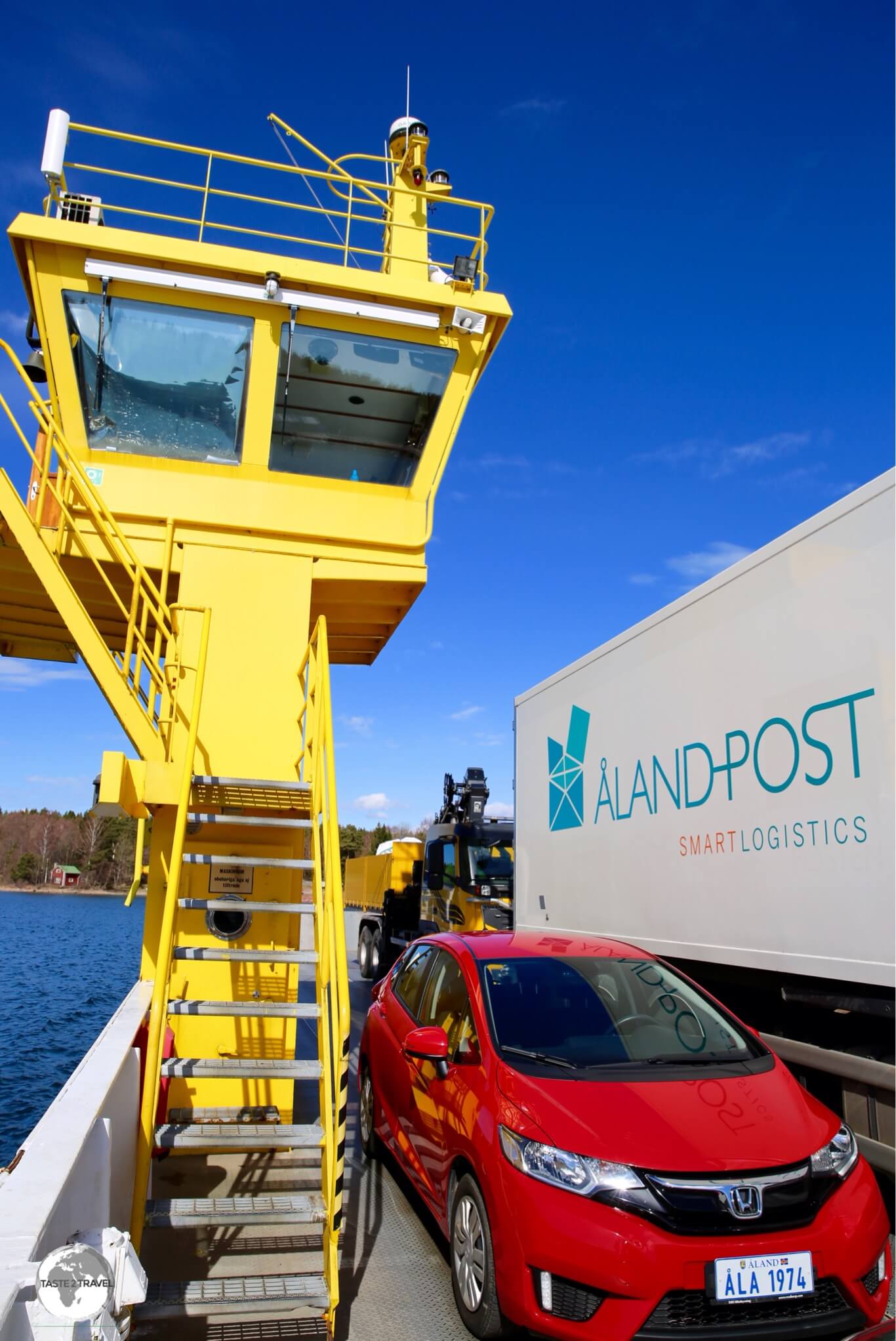
My rental car on a Cable ferry to Vårdö island.
Eckerö

Eckerö church is dedicated to St. Lawrence.
The most western municipality, the highlights of Eckerö are its impressive church (first built in 1280 and dedicated to St. Lawrence) and Degersand, the most beautiful sand beach on the Åland Islands where you have accommodation options.

Located on the south coast of Eckerö, Degersand is the most beautiful sand beach on the Åland Islands.
Lumparland

The steeple of Lumparland church, the oldest surviving wooden church in the Åland islands.
Lumparland is the smallest municipality on mainland Åland, supporting a population of 396. The Church of Lumparland, dedicated to St. Andrew, is the oldest surviving wooden church in Åland, dating back to the 1720’s.
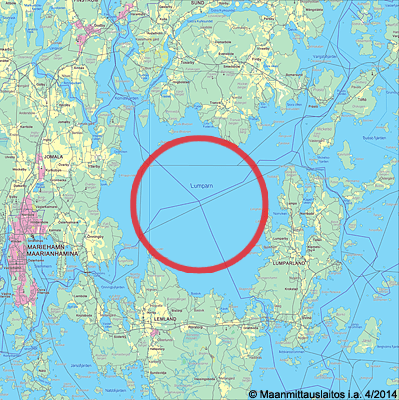
The red circle indicates the body of water known as the Lumparn, a 9 km wide meteor impact crater. Source: somerikko.net
Lumparland borders the eastern edge of a body of water known as the Lumparn, a billion-year-old, 9 km wide meteor impact crater. I’m glad I wasn’t around to witness that!
Accommodation

My comfortable room at the Hotel Arkipelag in Mariehamn.
There are many accommodation options on the Åland Islands from deluxe hotels to camping grounds and everything else in between, all of which can be found on the official VisitÅland.com website.
I stayed on the waterfront in Mariehamn at the Hotel Arkipelag which was wonderful. The hotel offers spacious, stylish rooms with harbour views, an excellent breakfast buffet (which always featured a gourmet selection of fine Åland produce), a bar and casino and everything else you would expect from a four star hotel.
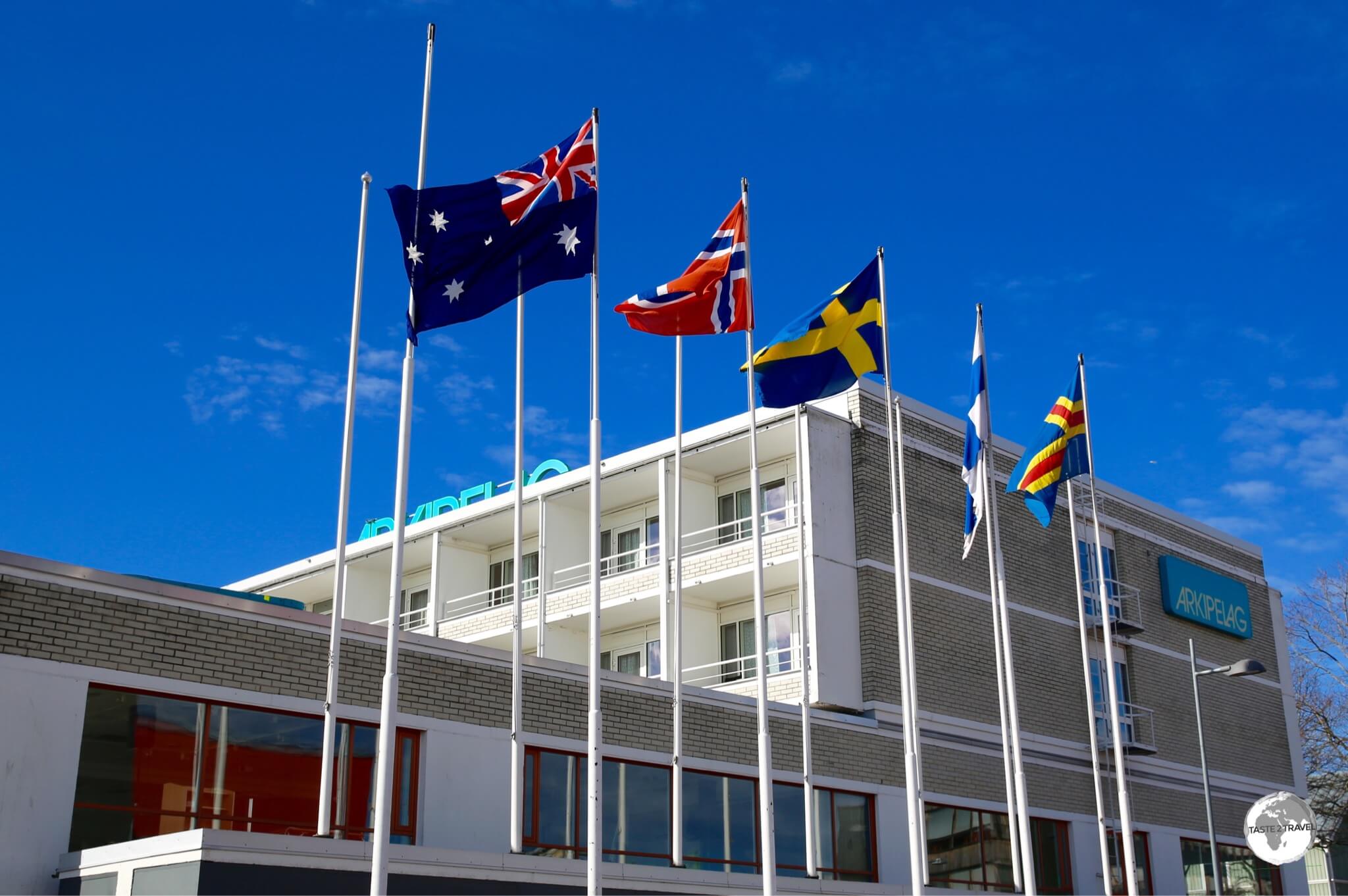
The Australian flag flew outside the Hotel Arkipelag for the duration of my stay.
One thing I didn’t expect was to walk outside the hotel on my first morning and see the Australian flag fluttering in the cool, crisp breeze. The only other flags flying were those of the neighbouring Scandinavian countries and the Åland Islands. I asked the receptionist why they were flying the Australian flag and she confirmed my suspicion that it was to honour my visit. So – if you wish to stay somewhere that’ll fly your flag and leave you feeling like a VIP, then I recommend the Hotel Arkipelag.
Eating Out
The Åland Islands are one of the few places in Europe where you’ll find none of the regular international fast food restaurants. The only nod to fast food is one restaurant from the Finnish burger chain, Hesburger, who offer the ‘Double Burger’, which looks exactly like a Big Mac.
Mariehamn

Many tempting offerings to be found at Bagarstugan Café in Mariehamn.
Mariehamn is a wonderfully compact, pedestrian friendly capital and most restaurants, café’s and bars are located a short walk from each other. My go-to place while in town (and the best café I found anywhere in Åland) is the very cosy and inviting Bagarstugan Café & Vin.
Everything here is divine, from the coffee, cakes, food, service, décor and ambiance and I believe the world would be a much better place if every town had a Bagarstugan café!
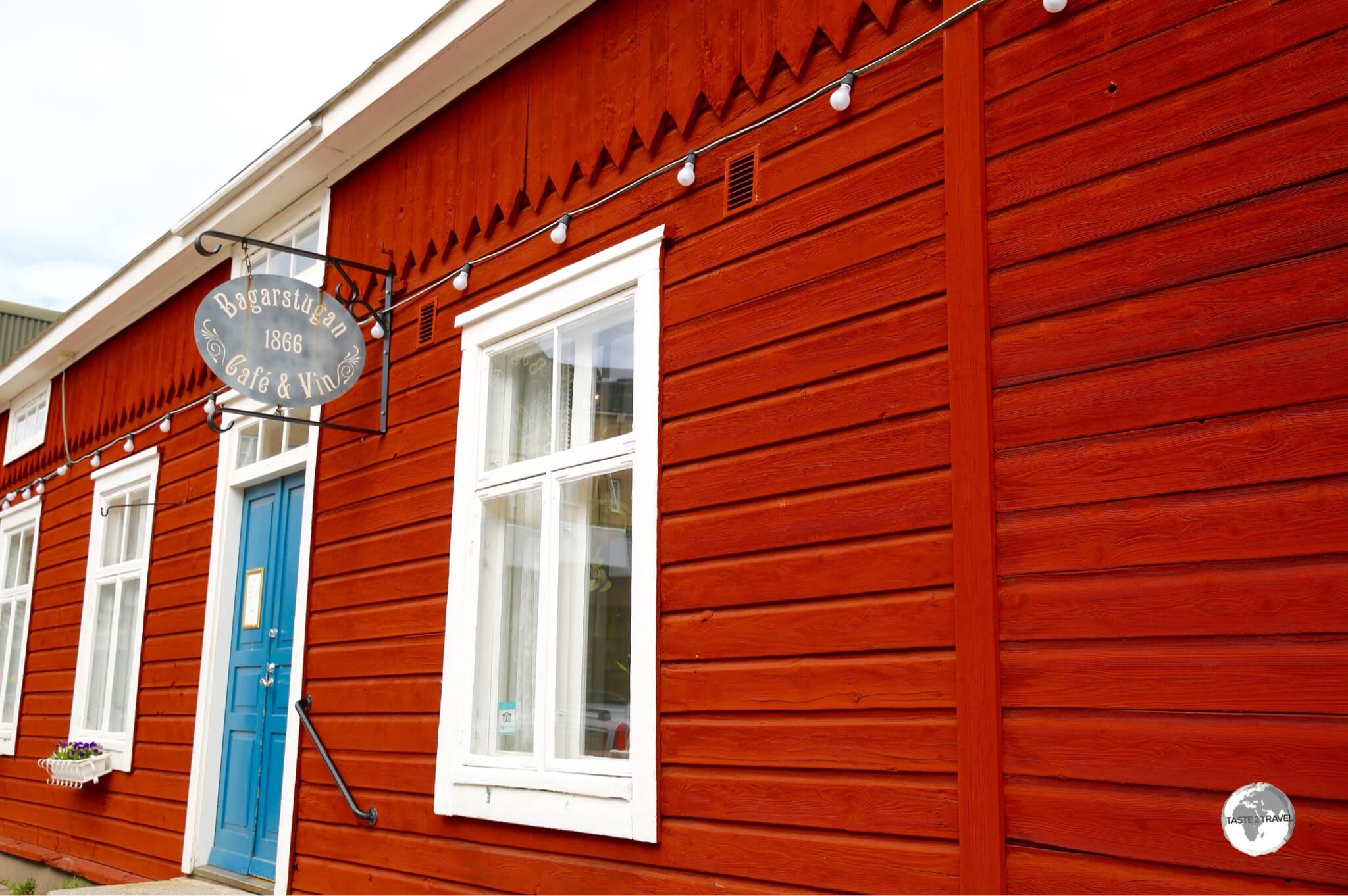
Exterior of Bagarstugan café in Mariehamn.
Bagarstugan is strictly a daytime operation, however there are plenty of nocturnal dining options a few steps away. One of my favourites was the lively upstairs restaurant at Indigo Restaurant & Bar. Both the food and drinks selection were superb, with the talented bar staff able to create any cocktail one desires (the Pisco Sours were the best this side of Peru).
Located between Indigo and Bagarstugan is Dino’s Bar & Grill, which is an American-style sports bar featuring live music and a menu loaded with American classics (hamburgers, ribs etc).
Outside Mariehamn

Beer tasting at the Stallhagen Brewery.
Almost all dining/ bar options are located in Mariehamn but one worth journeying to (15 kilometres north of the capital) is the fantastic Stallhagen Brewery which is located a short drive west of Godby on route 4.
Stallhagen was the first micro-brewery on Åland and today produces a dozen different types of craft beers from pale ale’s to darker stouts to berry-infused (blueberry ale or raspberry stout) concoctions – all of which are very quaffable.
One of their more popular beers is Honungsöl, which includes local honey. The manager told me as a result of the popularity of this beer, Åland farmers are now increasing honey production to meet the demand from the brewery.

Home-made sausages are perfectly complimented with a selection of craft beers at Stallhagen Brewery.
The brewery restaurant produces an amazing selection of dishes which are nicely paired with different beers by the friendly, enthusiastic staff. I returned more than once for their lunch special which was home-made sausages served with mashed potatoes and sauerkraut.
This was paired with a small selection of their beers which were served in tasting glasses. By the end of my stay I had sampled their full range!

An Åland pancake paired with two different stouts at the Stallhagen brewery.
The brewery is a good place to try the famous Åland pancake which is semolina based and pairs very well with a full-bodied stout.
Visa Requirements
Being a territory of Finland, the visa policy of the Schengen area applies to the Åland Islands.
Immigration Formalities
All sea and air connections are with neighbouring Schengen members (Finland, Sweden or Estonia), hence there are no immigration checks upon arrival and no passport stamps issued.
Getting There

Air & sea routes to the Åland Islands. Source: www.Aland.com
Air
Flights to the Åland Islands arrive at the sleepy Mariehamn airport, which is located 3 kilometres (2 miles) north-west of the capital in the municipality of Jomala.
On the evening I arrived from Stockholm (on the last flight of the day), there were no taxis at the airport so I called for one using the free public phone. In the meantime, everyone else had left the terminal which left me and the security guard, who announced he was going home and left me alone inside the terminal to wait for my taxi. Crime is unheard of on the islands and the Ålanders are very laid-back and relaxed.
The following airlines provide connections with the outside world:
Airport Transport
There are no airport bus services while a taxi from Mariehamns Taxi will cost between €15-20 to downtown.
Ferry
Most visitors to the islands arrive by sea from either Sweden, Finland or Estonia. Currently four ferry companies provide regular international services to the islands:
- Eckerö Linjen – Provides connections between the Åland Islands and Grisselhamn (Sweden)
- Finnlines – Provides connections between the Åland Islands and Kapellskär (Sweden) and Naantali (Finland).
- Tallink Silja – Provides connections between the Åland Islands and Stockholm (Sweden), Turku (Finland), Helsinki (Finland) and Tallinn (Estonia).
- Viking Line – Provides connections between the Åland Islands and Stockholm (Sweden), Kapellskär (Sweden), Turku (Finland), Helsinki (Finland).
Getting Around
Bus
Buses connect Mariehamn to most parts of the ‘mainland’ and are operated by Williams Buss and Viking Lines Buss. The following routes allow visitors to reach most parts of the archipelago:
- Route 1 – Is operated by Williams Buss and connects Mariehamn to Hammarland then Ekerö.
- Route 2 – Is operated by Viking Lines Buss and connects Mariehamn to Godby then Geta.
- Route 3 – Is operated by Viking Lines Buss and connects Mariehamn to Godby then Saltvik.
- Route 4 – Is operated by Viking Lines Buss and connects Mariehamn to Godby then Sund then Vårdö.
- Route 5 – Is operated by Williams Buss and connects Mariehamn to Lemland then Lumparland.
- Route 6 – This circuitous route is operated by Williams Buss, connecting Mariehamn to Godby, Gölby, Emkarby, Pålsböle then back to Godby then Mariehamn.
All buses depart from the Bussplan in downtown Mariehamn. You can view route information, timetables and current fares on the Ålandstrafiken website.
Ferry

A map showing domestic ferry routes. Source: Ålandstrafiken
There are four domestic ferry routes which are operated by Ålandstrafiken; the Northern line (Norra linjen), the Southern line (Södra linjen), the Cross line (Tvärgående linjen) and the Föglö line (Föglölinjen). You can view route information, timetables and current fares on their website.

The Captain on the bridge of a Cable ferry on Vårdö Island.
In addition to these, a number of ‘cable ferries‘ (which run on a fixed cable) provide a connection between some of the islands.

The Cable ferries run on a submerged cable, which is strung between islands.
The Cable ferries are free of charge and run on demand (i.e. it only takes one vehicle to initiate a crossing) with one captain telling me that these state-run ferries never stop running and are hugely expensive (all that fuel!).

Crossing to Vårdö island on a cable ferry.
Taxi

A taxi in Mariehamn, nice to ride but expensive.
Mariehamns Taxi can be contacted locally on 018-10066 or from abroad on +358 18 26 000. With a flag fall of €6 and a per kilometre charge of €3, taxis are not cheap.
Rental Car

My rental car on the Åland Islands.
The best way to maximise your time on the islands is to rent a car. Many of the remote back-roads are not served by public transport and since traffic is light and the roads are (generally) in excellent condition, you can cover most of the archipelago in a few days.
Rundbergs (Tel: +358 (0) 18 525 505) are the only rental agent on the Åland Islands and are also the local representative for Europcar & Hertz. Their office is hidden away inside the ST1 service station, which is located on the waterfront in Mariehamn. You do not need to visit them as they will deliver your car to you.
Being a monoploy operator, rates are never going to be favourable and a compact car will set you back €82 per day (for multiple days hire) or €427 per week. If you wish to hire a car for just the day, they offer a special rate of €68.
This is the end of my Åland Islands Travel Guide.
Safe Travels!
Darren
Follow me on Instagram:
[instagram-feed feed=1]
Further Reading
Other travel reports from the Nordic region:
Åla Islands Travel Guide Åland Islands Travel Guide Åland Islands Travel Guide Åland Islands Travel Guide Åland Islands Travel Guide Åland Islands Travel Guide Åland Islands Travel Guide Åland Islands Travel Guide Åland Islands Travel Guide Åland Islands Travel Guide Åland Islands Travel Guide Åland Islands Travel Guide Åland Islands Travel Guide
Author: Darren McLean
Darren McLean is an Australian, full-time, digital nomad who has spent 37 years on a slow meander around the globe, visiting all seven continents, 192/ 193 UN countries and 245/ 251 UN+ countries and territories.
He founded taste2travel to pique one’s curiosity and inspire wanderlust.







